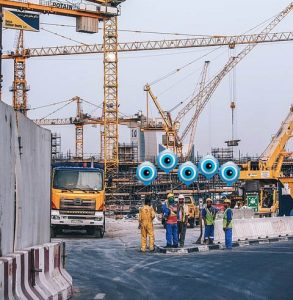Legislation concerning CheckInAtWork
We like to keep things simple and transparent. So we have briefly summarised all the rules for you. It is mandatory to submit a Worksite Notification for certain types of worksites and all employees at these worksites must record their attendance electronically. Read on this page information about the legislation regarding CheckInAtWork.

Attendance recording (Checkinatwork) on arrival at the worksite has been made mandatory since 1 April 2014. This applies to construction sites where the total costs of the works is 500,000 euros or higher. You can save a lot of time by automating your attendance recording. There are several ways to ensure that Checkinatwork progresses in a smoother manner. For example, you are free to choose the most suitable option for your company. Attendance recording can, for example, be done via a badge reader or a time clock. Do you want more information about Checkinatwork? Please contact us via the form on our website.
Worksite Notification
Whereas earlier different administrative departments needed to be contacted, it is now sufficient to submit a single Declaration of Works at the NSSO.
What type of works?
Almost all works that pose a risk to the health and safety of employees.
Exceptions
- Works not involving a subcontractor which cost less than 30,000 euros (excluding VAT)
- Works involving a subcontractor which cost less than 5,000 euros (excluding VAT)
Checkinatwork (attendance recording) in the construction sector
It is mandatory to record attendance at specific construction sites. These construction sites must have a total cost of 500,000 euros excl. VAT or more.
Who does this apply to?
This legislation applies to blue-collar workers, self-employed persons, safety coordinators, etc., i.e. all persons actively involved in the works carried out at the site. Engineering firms and EPB reporters are not required to check in. Checkinatwork is also not required for people who visit the worksite occasionally.
In practice, this naturally leads to many uncertainties. An example:
- A driver comes to deliver something: not required to check in since he is only visiting the worksite and not carrying out any work activities there
- A driver comes to deliver and install something: required to check in since he is carrying out activities at the worksite
In short, carrying out any activity related to the construction works almost always means that the person is required to check in.
Responsibility
The main contractor is responsible for Checkinatwork. It must inform its subcontractors that attendance recording is mandatory and also ensure that they check in correctly. The NSSO helps by sending an email in advance, in which they indicate whether a certain worksite meets all the conditions with regard to attendance recording.
Mandatory data to be recorded
The following data must be recorded for the electronic attendance recording system in the construction sector:
- Employee personal data (National Register Number, BIS Number or L1 Limosa Number)
- Location of the worksite (via code entered in the Declaration of Works under 30a)
- Employer identification data (Company Number)
- Check-in date (not the time)
You can save a lot of time by automating your attendance recording. There are several ways to ensure that Checkinatwork progresses in a smoother manner. For example, you are free to choose the most suitable option for your company. Attendance recording can, for example, be done via a badge reader or a time clock.
Do you want more information about Checkinatwork? Would you like to read more about the legislation? Please leave us your details via our contact form, so that we can get in touch with you.






